Blog
Blog
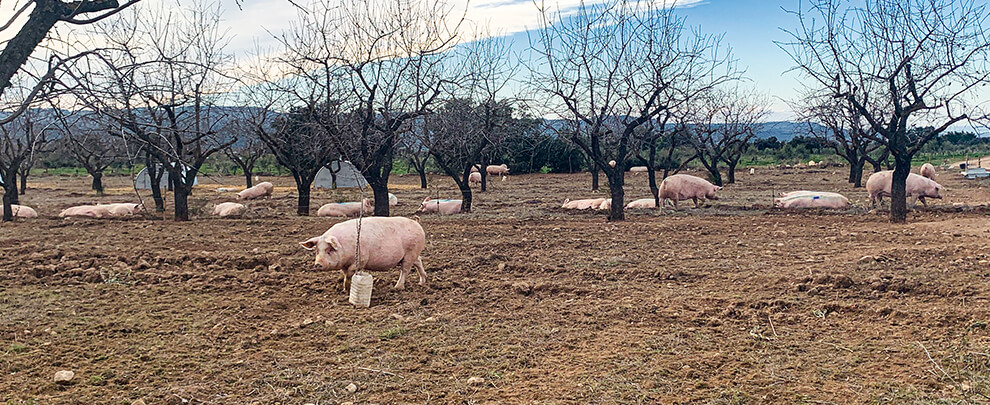
Ecological pig production in Lleida
06th April 2021 - News
Always dedicated to conventional pig production, four years ago, after learning about the organic pig projects that a close friend had, Eduard Cau set out to diversify his production towards organic pig farming. He began to learn about the production models implemented in other countries such as the United Kingdom, Germany, the Netherlands, and Australia.
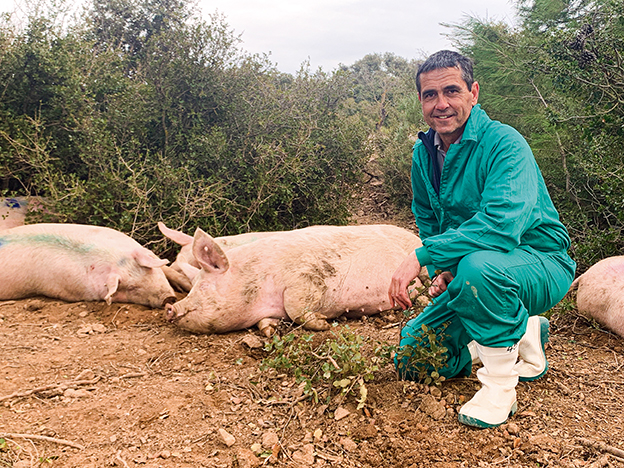
Eduard Cau, ganadero que ha puesto en marcha esta granja ecológica. Foto: Rotecna.
"When we began to investigate and learn how organic pig production was carried out, we saw that there were several models and important differences between them. What they all have in common is that they work with straw, without antibiotics, with organic food, and with high animal welfare levels. Still, they range from highly technical farms to simpler farms, like ours", Eduard explains, adding: "We work with the 'camping' model, which is the most widespread in the UK, but with some variations. In the United Kingdom, they use 20-hectare farms with 1,500 sows, that work for two years and are then dismantled to leave the ground to rest. We, on the other hand, think about having a stable farm over time, and what we do is move the sows from one plot to another so that the land rests for months before occupying it again." The main drawback of this type of management is that, apart from moving the sows and all the material periodically, the area needed multiplies, as does the initial investment of building this type of farm. In this sense, the Albi ecological farm project has meant an investment of 1.1 million euros.
"The growing grass represents 15% to 20% of the pigs' diet.
The rest of the feed is feed from organic cereals."
THE FARM
The facility has an area of 60 hectares and 250 sows. Animals occupy 10% of the total area, with rotational whereabouts, meaning there is no environmental impact from the slurry on the ground. "Having a sufficient area, the plots are occupied and vacated from time to time to put them to rest for months and give the grass a chance to grow again," explains Eduard. He assures: "With this, high soil fertility is achieved, which is even appreciated in the colour of the soil," and the farm does not require rafts to store the slurry or facilities for its treatment.
Besides, thanks to the soil's high fertility, the growing grass represents 15% to 20% of the pigs' diet. The rest of the feed is feed from organic cereals.
Three people currently work on the farm handling 250 sows and the daily tasks: inspecting the animals' condition, feeding them, putting straw in the booths, inseminating, monitoring deliveries, taking care of piglets, etc. "The ratio of jobs in this farm model is multiplied by three and by four since the animal handling and movement model requires it", Eduard explains, adding that "it is important to note that we generate more stable jobs than are needed on a conventional farm."
DISTRIBUTION
Control cover
The farm has four insemination areas, the use of which alternates. The idea is that all farm plots, when vacated, rest for at least seven months before being reoccupied.
Confirmed gestation
There are plots of about 1,000 square meters with 25 animals each, which move weekly from one field to another to manage pregnant sows.
The great challenge in this phase is feeding the sows. "Currently, we are working ad libitum. And, although the truth is that despite this, the sows are in good bodily condition and are not excessively fat, the objective is to work with an electronic feeding system for outdoors", Eduard explains.
Food in organic production systems has costs between 70% and 80% higher than in conventional production, so they work to adjust feed consumption on the farm as much as possible.
"The farrowing squares are about 500 square meters each."
Farrowing
The farrowing squares are about 500 square meters each. The sows spend up to seven weeks there: one before delivery, and six lactating. After this time, the occupied plot remains at rest for seven months. In this way, when it is reoccupied, it is full of grass again.
Each plot has an isolated and fenced housing and a drinking fountain. "A lot of straw is put inside the booths in the days before delivery so that the sow prepares her space to give birth", Eduard explains, and adds: "After delivery, the piglets are inside the shed for 15 days without leaving, and then the fence is removed so that they can move freely through the plots."
Farrowing locations are lined up to facilitate their management, always leaving a free space between two occupied areas to supply food or access them as necessary.
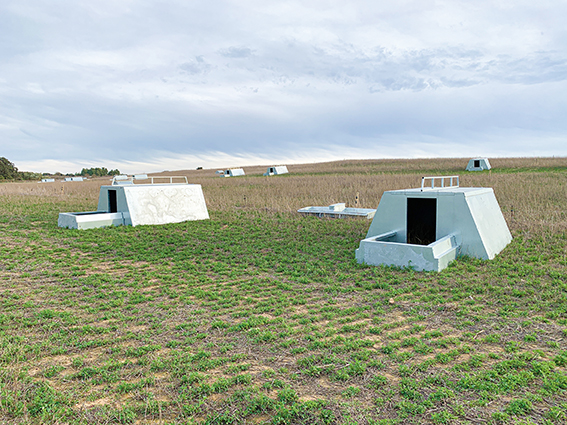
Farrowing places prepared for the first deliveries. Photo: Rotecna
Weaning
After six weeks of lactation and weighing 11-12 kilos, the piglets move to portable weaning pens with a surface area of 100 square meters with the capacity for 100 animals. They stay for seven weeks, by which time they have reached 25-30 kilos.
One of the most challenging moments in organic production is weaning, since, after six weeks of exclusive lactation, the piglets are transferred to these pens, and they go from drinking milk to taking solid feed without any additives or antibiotics, so it is a very abrupt change for the animals. "These are critical days for the animals. However, the positive part is that the conditions that piglets have in these pens are more favourable since they have soil, grass, straw, feed, and water to support their adaptation and development," Eduard explains.
Each pen has a hopper and a trough, and animals are offered straw for their comfort and the natural manifestation of their instinct to chill. After six weeks, the pens empty and piglets are moved and placed on clean ground, leaving the land to rest. After this, the piglets will be sent to an ecological fattening farm that Eduard Cau hopes to have working in the coming months in Els Omellons (Lleida), with a capacity for 5,000 spaces.
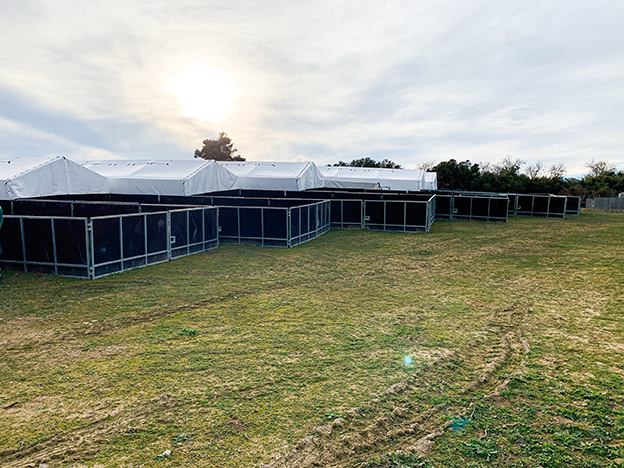
100m2 portable weaning pens and capacity for 100 piglets. Photo: Rotecna.
BIOSECURITY
One of the fundamental foundations of an organic farm is that it cannot treat animals with antibiotics. Besides certain exceptions, if necessary, treatments have to be individual, and treated animals must be segregated because they can no longer be sold as organic. For this reason, in this production system, diseases are the main enemy of ranchers, who fight with biosecurity measures to prevent their entry.
In this case, Eduard explains that the farm is isolated from other pig facilities by a radius of two kilometres. It has a four-kilometre perimeter fence with external “electric grass” to prevent access by wild boars and other animals that could be carriers of diseases. There is a biosecurity space between the fence and the farm five meters wide where there are never animals, which can only be accessed with farm clothing, and a truck for farm animals' placement exclusively.
PRODUCTIVITY
In the UK, the farms outdoors (exterior) have an approximate production of 24.5 piglets per sow per year, so the production is lower than that of conventional farms. "We, taking into account that we work with a longer lactation period, calculate that we will have an average of 20 piglets per sow, which, in a year, is an annual production of 5,000 piglets," says Eduard. However, this figure could reach 15,000 piglets in one or two years when Eduard plans to expand the farm to 100 hectares and have a total of about 600.
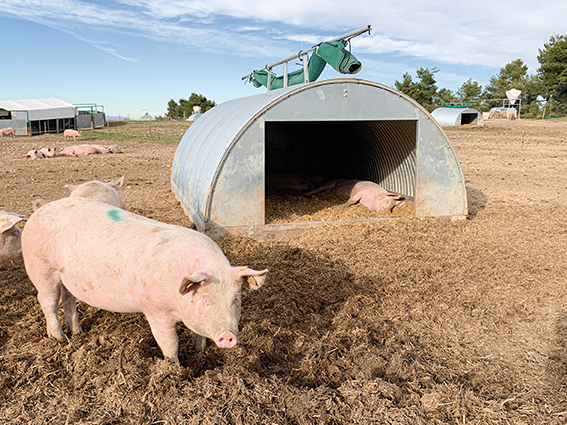
The Albi ecological farm works with the camping model. Photo: Rotecna.
PROFITABILITY
The costs of an ecological farm like that of the Albi are important, since a significant initial investment in land is required, the adaptation of spaces, the materials, and also investing in personnel for good management – all in addition to the costs of food. "We are aware that we work with a farm model whose costs are high but, at the same time, we are going to get a very high-quality product," Eduard says, acknowledging that it is challenging to undertake a similar project if you do not already have a client who is going to buy the production: "We make a very differentiated product focused on a specific type of client. Producing like this costs more than double that of a conventional farm, but the client is willing to pay for this product," he adds. In this sense, Eduard has a contract to sell his products at a fixed price, so that before starting the activity, he has already calculated the profit margins that make the project viable. "If all the calculated parameters are met, the production of an ecological farm gives more margin than that of a conventional farm," he says.
CHALLENGES
In addition to expanding the farm’s surface to reach 600 sows and launching ecological fattening at Els Omellons (Lleida), another challenge they are working on is optimising food costs, since, if it is expected to reach 15,000 piglets a year for fattening, these will consume an average of 5,000 tons of organic feed. This is why, Eduard works with nutritionist experts on a study of the production of organic cereals. They have rented 60 hectares on three different farms, where they carry out tests to make ecological protein. "The goal is to find farmers who want to grow this protein in exchange for our commitment that we will buy the product from them," he says.






